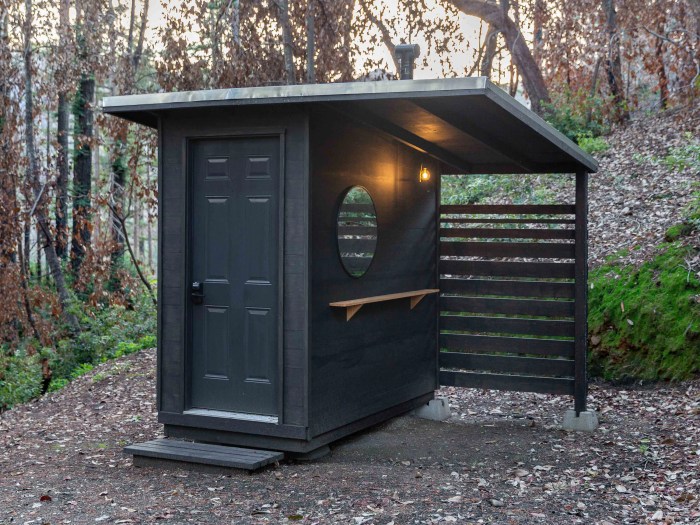DIY composting outhouses are becoming increasingly popular as a sustainable and environmentally friendly alternative to traditional septic systems. These structures offer a unique way to manage waste, turning it into valuable compost for your garden. This guide delves into the process of building and maintaining a DIY composting outhouse, covering everything from planning and design to waste management and safety.
A composting outhouse essentially consists of two main components: a toilet seat and a composting chamber. The toilet seat provides a comfortable and hygienic way to use the outhouse, while the composting chamber is where the waste is broken down naturally. This breakdown is achieved through a combination of aerobic and anaerobic composting processes, which involve the decomposition of organic matter by microorganisms in the presence and absence of oxygen, respectively.
Safety Considerations: Diy Composting Outhouse

Building and using a composting outhouse requires careful consideration of safety measures to ensure a healthy and secure environment. Potential hazards exist, and taking preventative steps is crucial to mitigate risks. Proper ventilation and hygiene practices are essential for a safe and functional composting outhouse.
Fire Hazards
Composting toilets rely on the breakdown of organic matter by microorganisms, which produce heat. This heat, if not managed properly, can lead to a fire hazard.
- Avoid using flammable materials near the composting chamber, such as paper or wood shavings. These materials can easily ignite if the temperature inside the composting chamber rises too high.
- Ensure adequate ventilation to allow heat to dissipate and prevent the buildup of flammable gases.
- Regularly monitor the temperature inside the composting chamber. If the temperature exceeds 160°F (71°C), take steps to cool it down, such as adding water or opening the vent.
- Install a fire extinguisher in a readily accessible location near the composting outhouse. It is important to know how to use it in case of an emergency.
Ventilation, Diy composting outhouse
Proper ventilation is crucial for a safe and functional composting outhouse. Adequate airflow prevents the buildup of harmful gases, such as ammonia and methane, which can be toxic.
- Install vents at the top and bottom of the composting chamber to allow for air circulation. The vents should be positioned to create a cross-ventilation effect.
- Ensure that the vents are properly sized and positioned to allow for adequate airflow. The size and placement of vents will depend on the size and design of the composting chamber.
- Regularly check the vents to ensure that they are not blocked or obstructed. This is particularly important during periods of heavy rain or snow.
Hygiene Practices
Maintaining good hygiene practices is essential for a safe and healthy composting outhouse. This includes proper handwashing, sanitation, and waste management.
- Wash your hands thoroughly with soap and water after using the composting outhouse. This helps to prevent the spread of germs and bacteria.
- Sanitize the composting outhouse regularly. This can be done by spraying the surfaces with a disinfectant solution. It is important to follow the manufacturer’s instructions for the disinfectant.
- Dispose of waste properly. This includes using the composting outhouse only for human waste and avoiding the disposal of other materials, such as food scraps or animal waste.
- Keep the composting outhouse clean and free of debris. This will help to prevent the buildup of bacteria and other harmful microorganisms.
Building and maintaining a DIY composting outhouse is a rewarding experience, allowing you to contribute to a greener lifestyle. With careful planning, proper construction, and regular maintenance, you can create a sustainable and efficient waste management system that benefits both your home and the environment. As you embark on this journey, remember to consider your local regulations and permits, ensuring compliance with environmental standards. By embracing this innovative approach to waste management, you can become a champion of sustainable living, leaving a positive impact on the planet for generations to come.
Building a DIY composting outhouse can be a rewarding project, offering a sustainable and eco-friendly way to manage waste. While composting toilets are a great way to reduce your environmental impact, it’s important to be aware of potential health risks, such as the possibility of bacterial contamination. Some bacteria, like the one responsible for producing the antibiotic amikacin , can be harmful if not properly managed.
Properly constructed and maintained composting outhouses can minimize these risks, making them a viable option for those seeking a more sustainable lifestyle.
